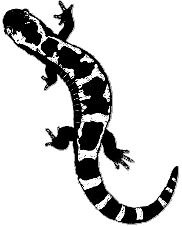Salamanders are generally short-bodied, four-legged, moist skinned animals, about 4 to 6 inches long. They are often boldly patterned or brightly colored. Salamanders feed on insects, worms, snails, and other small animals, including members of their own species. Like other amphibians they absorb water through their skin and require a moist habitat.
In regions where temperatures reach below freezing, they often hibernate. Most adult salamanders hide by day and feed by night. Some remain hidden underground until breeding season, or they may emerge when levels of moisture and temperature are appropriate. They have no claws, scales, or external ear openings.
There are three types of salamanders: totally aquatic, semi-aquatic, and completely terrestrial. The aquatic live their complete life cycles in water. The semi-aquatic primarily live on land, hibernating during winter, and entering water as breeding season begins. After mating is complete they once again return to land. The terrestrial salamanders spend their entire lives on land, rarely entering water although they lare never far from it.
Fertilization is usually internal. Males often produce a spermataphore (sperm case) which the female takes into her body. Breeding often occurs in the water, but members of the Salamandridae and Plethodontidae families breed on land. |



